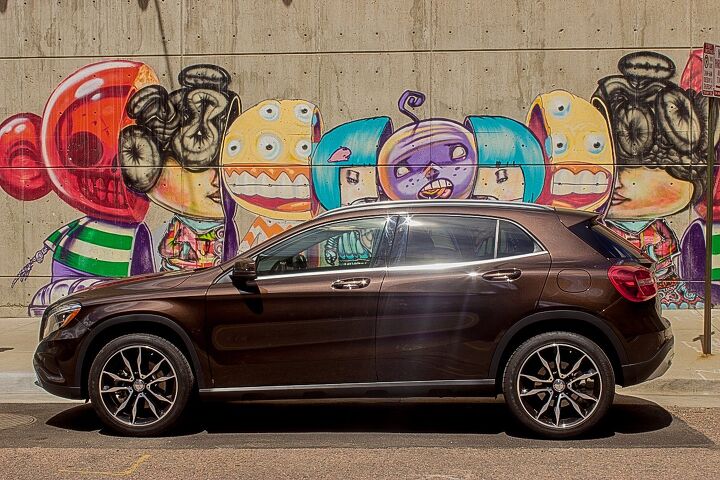2015 Mercedes-Benz GLA250 4MATIC: Lookin' for Love

The 2015 Mercedes-Benz GLA250 lives within the margins.
The compact — which shares more in common with a hatchback than an SUV — has a life thanks to America’s all-things-crossover obsession. It dodges definition, shirks consistent fuel-economy ratings and even has me guessing on my own feelings toward it. For sure, I can’t find a single offensive thing about the GLA. Even more, I can’t find a single thing to love.
The Tester
2015 Mercedes-Benz GLA250
Engine: 2.0-liter inline, turbocharged 4-cylinder (208 horsepower @ 5,500 rpm; 258 pound-feet @ 1,250-4,000)
Transmission: 7-speed DCT transmission with paddle shifters
Fuel Economy (rating): 24 mpg city/32 mpg highway/27 mpg combined
Options: Cocoa brown exterior paint; Satin light brown poplar wood trim; Blind-spot assist; Bi-xenon headlamps; 19-inch wheels; Premium package (satellite radio, heated front seats, harman/kardon audio, dual-zone climate control); Multimedia package (navigation, 7-inch high-resolution display, DVD player, traffic information).
Base price: $33,300
Exterior
That’s not an indictment on the GLA’s overall looks. The GLA’s stretched sheet metal from front to back look downright futuristic compared to the BMW X1 and Lexus NX. Maybe not as classically handsome as the Range Rover Evoque and a coin-flip compared to the Audi Q3, but there is nothing about the GLA that outwardly screams “half-baked.” It’s clear that German engineers set out to build a handsome crossover that happened to be a Mercedes, and not a Mercedes crossover that happened to be handsome. In my opinion, the GLA is too busy to look “classic” Mercedes.
Even the tail, which has the unenviable task of tying together the multiple body lines and profile curves, looks solidly modern and scrutinized. If I had to nitpick — and I think I have to — the bulbous tail lamps have a whisper of ugly.
Up front, however, the GLA’s nose and grille present a compelling argument. The car, which starts at just over $34,000, looks more expensive from the front. It’s a case of Mercedes putting a better foot forward for entry buyers. I prefer the GLA’s nose over, say, the boxy approach of the GLK, but the GLA’s face is much less polarizing.
The thick C-pillar visually lengthens the GLA’s abrupt end and gives the car a longer approach than its 179-inch measurement would indicate. From all approaches, the GLA looks bigger outside than it actually is, and that’s not a bad thing.
Shod with our optional 19-inch wheels the GLA sits tall and muscular without being gaudy. If the Subaru Forester had a Y chromosome, it’d look like a Mercedes-Benz GLA.
Interior
First, the familiar: the Mercedes-Benz three-spoke wheel in the GLA is an exceptional touch. The wheel feels solid and confident, and its steering wheel controls and paddle shifters are among the best in the business right now.
Additionally, Mercedes-Benz’s COMAND system (its infotainment interface) is clear and fabulously unfussy. Pairing a smartphone or dictating an address is a breeze, and the 7-inch high-resolution display is seamlessly integrated into the GLA (albeit for $2,480 extra) without looking like a 80-inch HDTV in a trailer home.
The GLA even looks the part too. The ballyhooed cross-hair air vents are impressive, and even the beige faux-leather seats would have me second-guessing shelling out $1,700 for the privilege of more hides between the doors.
But it doesn’t take long for impressions to settle into reality.
The three-spoke wheel hides the stalk and makes setting cruise control nearly impossible. The controls for the COMAND system are awkwardly placed somewhere between my elbow and my wrist, and the dash sounds unsettlingly too hollow.
Even the comfortable-looking MB-Tex seats started to flatten the longer I was in the car and after 2 hours in a hot car driving through the city, I found myself itching to get out.
If I can use a small example: the GLA’s electric-adjustable seat controls are in the doors, like every other new Mercedes-Benz. Unlike some of them, the GLA doesn’t have electrically adjustable headrests, but there’s still a piece of fixed-molded plastic where that slider would go. In short, the GLA has all the look inside that a Mercedes should have, but it’s just not as special.
(Spring for the leather seats and you get a MB-Tex-stitched dash upper, which could kill two birds with one stone.)
The rear seats are comfortable for adults on short to moderate trips. My 6-foot-2-inch frame could fold into the back behind the driver, but not with someone my size driving up front.
Infotainment
However, the COMAND system is thoughtfully integrated and wasn’t much of a distraction for me. I’m incredibly familiar with the layout and controls, so it’s hard for me to comment on the system’s learning curve. However, I can report that after teaching passengers how the small-ish knob placed near the cup holders could slide AND rotate, very few people had trouble learning the system.
The good: The radio controls mimic a tuner, and the system is detailed without needing too much attention.
The bad: Adding a phone, then adding that same phone as a Bluetooth streaming device is a head scratcher.
The ugly: The control knob is far-too small for my big mitts.
In the new C-Class, the COMAND system is nearly impossible to beat. In the GLA, it’s very good.
Drivetrain
The GLA250 sports a 2.0-liter turbo four that makes an entirely approachable 208 hp. According to the manufacturer, the GLA250 runs up to 60 mph in around 7 seconds, which may not be blinding, but may not be the engine’s fault. The 7-speed DCT transmission does its very best to keep the GLA in low-rev, fuel-saving territory on the tach and it’s apparent. More than a few times, I guessed I was in third gear by the other side of the intersection, and the GLA’s long legs are built for wringing every last mile from its 15-gallon tank.
Unfortunately, it’s a losing attempt.
Despite my best efforts on long highway jaunts, I couldn’t approach 30 mpg consistently, and the GLA may be thirstier than its 27 mpg combined rating would indicate.
In combined driving, over nearly 200 miles, I managed only just over 25 mpg without over-taxing the GLA or touching the paddle shifters.
The GLA is offered in front- or all-wheel drive, which Mercedes calls 4MATIC, configurations. Our tester was the latter, but without much snow or mountain driving to be found over the past week, it’s hard to report whether the all-wheel drive is necessary. We’ll blame El Nino. Or something.
Drive
The GLA is easy to park and remarkably maneuverable around an Ikea parking lot (if you’re wondering what I did with it instead of driving into the Rockies.)
There are some niggles, however. The GLA is far from quiet inside. A considerable amount of road noise comes through into the cabin and it feels like Mercedes just skipped some of the sound deadening material in the final checklist.
Also, Mercedes’ collision prevention assist system isn’t any more advanced than anyone else’s, which means that it’s entirely too intrusive. In stop-and-go traffic, the system tripped a few times and warned of a low-speed collision that wasn’t going to happen anyway.
And if I could coax the transmission into shorter shifts at the risk of less impressive fuel economy (on paper), I would. Mash your right foot, count to three and then the GLA clambers forward. There’s too much time between action and reaction for a car that costs more than $40,000.
But there’s nothing wholly unsatisfactory about the GLA. It looks impressive and delivers a product that’s nearly better than anyone else’s. It’s better looking than the NX, more modern than the X1 with more interior potential than the MKC at a price that’s on target for what I’d expect from the three-star folks.
It’s just, coming from the company that recently made an extremely good C-Class car, the only thing I could define about the GLA was my extremely high expectations before I drove it. And maybe that’s just not fair.

More by Aaron Cole
Latest Car Reviews
Read moreLatest Product Reviews
Read moreRecent Comments
- ToolGuy First picture: I realize that opinions vary on the height of modern trucks, but that entry door on the building is 80 inches tall and hits just below the headlights. Does anyone really believe this is reasonable?Second picture: I do not believe that is a good parking spot to be able to access the bed storage. More specifically, how do you plan to unload topsoil with the truck parked like that? Maybe you kids are taller than me.
- ToolGuy The other day I attempted to check the engine oil in one of my old embarrassing vehicles and I guess the red shop towel I used wasn't genuine Snap-on (lots of counterfeits floating around) plus my driveway isn't completely level and long story short, the engine seized 3 minutes later.No more used cars for me, and nothing but dealer service from here on in (the journalists were right).
- Doughboy Wow, Merc knocks it out of the park with their naming convention… again. /s
- Doughboy I’ve seen car bras before, but never car beards. ZZ Top would be proud.
- Bkojote Allright, actual person who knows trucks here, the article gets it a bit wrong.First off, the Maverick is not at all comparable to a Tacoma just because they're both Hybrids. Or lemme be blunt, the butch-est non-hybrid Maverick Tremor is suitable for 2/10 difficulty trails, a Trailhunter is for about 5/10 or maybe 6/10, just about the upper end of any stock vehicle you're buying from the factory. Aside from a Sasquatch Bronco or Rubicon Jeep Wrangler you're looking at something you're towing back if you want more capability (or perhaps something you /wish/ you were towing back.)Now, where the real world difference should play out is on the trail, where a lot of low speed crawling usually saps efficiency, especially when loaded to the gills. Real world MPG from a 4Runner is about 12-13mpg, So if this loaded-with-overlander-catalog Trailhunter is still pulling in the 20's - or even 18-19, that's a massive improvement.









































Comments
Join the conversation
"The GLA’s stretched sheet metal from front to back look downright futuristic compared to the (...) Lexus NX." Come again? "It’s better looking than the NX" Thanks for letting us know...
GLA looks more futuristic than NX? :) Yeah right! I think NX is the most modern and sharp looking SUV in recent years, GLA looks downright boring. Reviewing design is always like stepping on ice with only socks on.